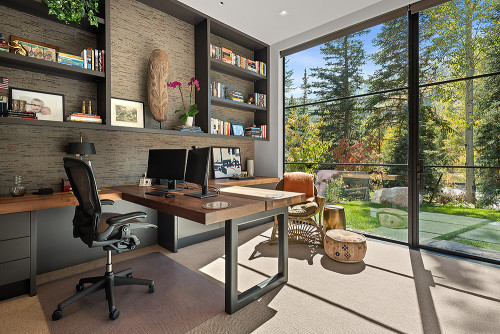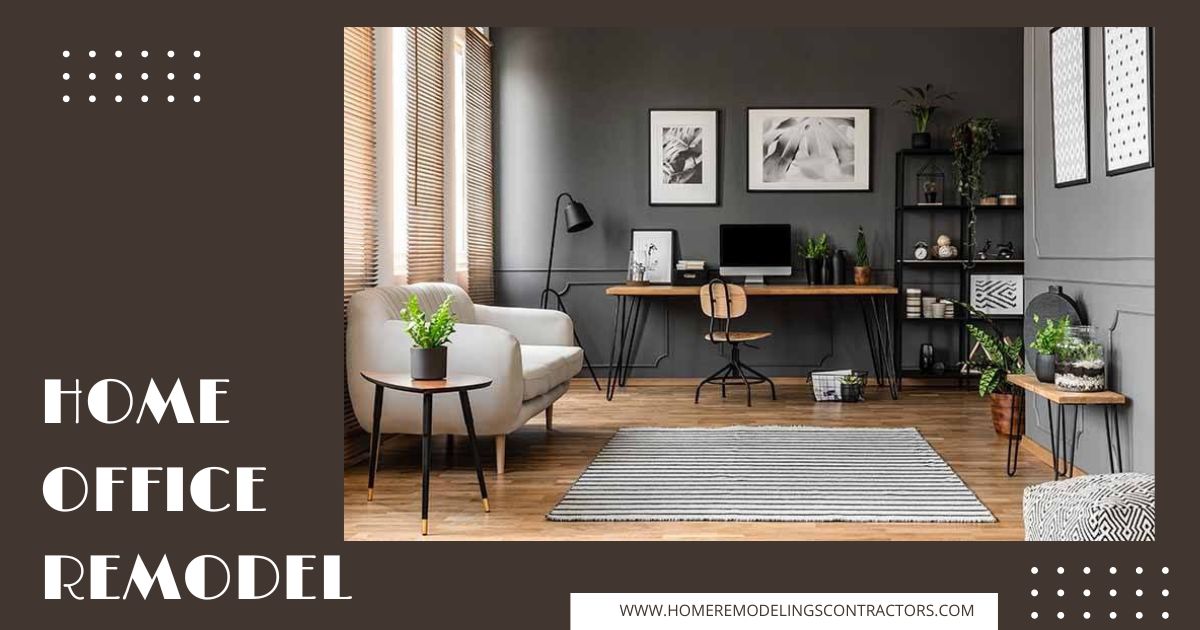The trend of remote work and telecommuting has skyrocketed recently, leading to a significant increase in the demand for home offices. A dedicated workspace in your home can provide numerous benefits, including increased productivity, reduced distractions, and improved mental health. However, a poorly designed or cluttered workspace can have the opposite effect, leading to decreased motivation and decreased efficiency. That’s why it’s crucial to do a home office remodel to meet your specific needs and ensure that it promotes productivity and comfort.
Home office Remodel
Assessing Your Current Space
The first step in remodeling your home office is to assess your current space. Take a look at the layout, the furniture, the lighting, and the overall atmosphere. Ask yourself the following questions:
- Is the space conducive to productivity and comfort?
- Do you have enough room to work comfortably?
- Is there enough natural light?
- Is the furniture functional and ergonomic?
Based on your answers, you can determine what changes you need to make to optimize your home office for maximum productivity and comfort.
Maximizing Space and Functionality
One of the biggest challenges in home office renovations is maximizing space and functionality. Make the most of your office space by following these guidelines.
- Invest in multi-functional furniture, such as a desk with built-in storage or a pull-out keyboard tray.
- Make use of vertical space by installing shelves or a wall-mounted desk.
- Use wall-mounted organizers to keep your desk clutter-free.
- Choose a desk that fits your specific needs, such as a standing desk to reduce sedentary time or an L-shaped desk if you need more room to spread out.
Improving Lighting and Atmosphere
Good lighting is crucial for a comfortable and productive workspace. Consider installing artificial lighting or a skylight if your home office doesn’t have enough natural light. To make your home office more pleasant to work in, consider the following suggestions:
- Use task lighting to illuminate your workspace, such as a desk or floor lamp.
- Install adjustable lighting to control the brightness and mood of the room.
- Consider adding a light therapy lamp to boost your mood and energy levels.
- Choose colors and textures, such as soft blues or greens, that promote calmness and relaxation.
Ergonomic Furniture and Equipment
Ergonomic furniture and equipment are essential for a comfortable and productive workspace. They can help prevent discomfort, pain, and injury and increase efficiency and motivation. Here are some tips for choosing ergonomic furniture and equipment:
- Choose a comfortable and supportive office chair with adjustable height and lumbar support.
- Invest in a good-quality keyboard, mouse, and monitor.
- Adjust the placement of your screen so that it is at the ideal distance from your eyes.
- Use a document holder to reduce neck and eye strain.
Storage Solutions
Clutter and disorganization can lead to decreased productivity and decreased motivation. That’s why it’s crucial to have effective storage solutions in your home office. Here are some tips for creating an organized workspace:
- Use labeled bins and baskets to store paperwork, supplies, and other items.
- Invest in a filing cabinet or a wall-mounted file holder to organize your paperwork.
- Use a pencil cup, a paper clip holder, and other desk organizers to keep your workspace clutter-free.

Home Office Design Ideas: Creating a Productive and Comfortable Workspace
- Industrial Chic: Combining exposed brick, steel beams, and reclaimed wood, this design style can create a bold and rustic vibe in your home office.
- Minimalist: A minimalist design style can create a calm and focused atmosphere in your home office. Use clean lines, neutral colors, and simple forms to create a space that promotes productivity and comfort.
- Nature-Inspired: Bring the outdoors in by incorporating natural elements such as plants, wood, and stone into your home office design. This design style can create a serene and relaxing environment that promotes productivity and well-being.
- Bright and Bold: Add a pop of color to your home office with bright and bold accents. Use bright colors on the walls, furniture, or accessories to create an energetic and inspiring workspace.
- Scandinavian: This design style is characterized by simplicity, functionality, and a focus on natural materials. Use light colors, clean lines, and natural textures to create a warm and inviting workspace.
- Traditional: Create a classic and elegant workspace by incorporating traditional design elements such as ornate furnishings, rich colors, and decorative accents.
- Luxe: Add a touch of luxury to your home office with elegant furnishings, rich fabrics, and stylish accents. Use high-end materials like leather, velvet, and gold accents to create a sophisticated and upscale workspace.
- Rustic: Create a cozy and inviting workspace with a rustic design style. Use natural materials like wood and stone and incorporate warm colors and textures to create a comfortable and inviting environment.
- Modern: Use a sleek and contemporary design style to create a modern and stylish workspace. Use clean lines, minimalistic furnishings, and bold accents to create a space that promotes productivity and efficiency.
- Fun and Playful: Add a touch of fun and creativity to your home office with playful accents and bold colors. Use whimsical artwork, fun accessories, and bright colors to create a lighthearted and inspiring workspace.
Conclusion
Remodeling your home office is an investment in your productivity, comfort, and well-being. By assessing your current space, maximizing space and functionality, improving lighting and atmosphere, choosing ergonomic furniture and equipment, and implementing effective storage solutions, you can create a workspace that is conducive to increased productivity and comfort.
It’s important to remember that the process of remodeling your home office doesn’t have to be overwhelming or expensive. Small changes, such as adding a new lamp or reorganizing your desk, can significantly impact your workspace. The key is to focus on the changes that are most important to you and to make them a priority.
In conclusion, a well-designed home office can provide numerous benefits, including increased productivity, reduced distractions, and improved mental health. You can enjoy all the benefits of working from home by assessing your current space, making necessary changes, and creating a workspace that meets your specific needs.
FAQS
Is there a new home-office 2019 remodeling magazine?
A new home-office 2019 remodeling magazine would provide information on the latest trends, designs, and ideas for remodeling your home office. It would also offer tips on making the most of your space, creating a functional and comfortable work environment, and choosing the right materials and products for your home office remodel.
Can kitchen remodeling be deducted as home office expenses?
Kitchen remodeling expenses may not be deductible as home office expenses, as they are not directly related to your business. However, it’s best to consult with a tax professional or the IRS to determine the tax implications of your home office remodel.
How to handle remodeling for the home office?
To handle remodeling for your home office, it’s important to assess your current space, set a budget, and determine the project’s scope. You should also choose the right contractor or professional to help with the remodel, design your new home office, and prepare the space for the remodel.
How to remodel a home office?
To remodel a home office, you’ll need to assess your current space, set a budget, choose a design, and select a contractor or professional to help with the remodel. You’ll also need to prepare the space for the remodel, install new fixtures and furniture, and add the final touches to your home office.
What is the cost of renovating a home office?
The cost of remodeling a home office will depend on the project’s scope, the materials used, and the labor cost. A basic home office can cost anywhere from $1,000 to $10,000, while a more extensive remodel can cost $20,000 or more.
What are the benefits of remodeling a home office?
The benefits of remodeling a home office include improved productivity, increased comfort, better organization, and increased property value. A well-designed home office can also help you work more efficiently and effectively, providing you with a more enjoyable work environment.
How do I choose a contractor for my home office to remodel?
When choosing a contractor for your home office remodeling, it’s important to look for someone who is experienced, licensed, and insured. You should also check references, ask for a portfolio of previous work, and get a written estimate or contract.
What should I consider when planning my home office remodel?
When planning your home office remodel, you should consider your budget, the scope of the project, the timeline, and your specific needs and requirements for your home office. You should also consider your current home office space’s layout, design, and functionality.
How can I make my home office more functional and comfortable?
To make your home office more functional and comfortable, you can add storage solutions, incorporate ergonomic furniture, choose the right lighting, and select a color scheme and design that is both functional and aesthetically pleasing. You may make your office seem like a home by decorating it with pictures and plants.
